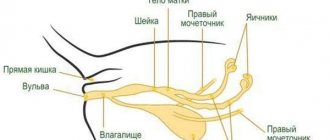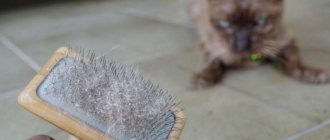9965Administration
1
Almost every owner who has cats has encountered a problem - the animal begins to vigorously scratch its ears, sometimes even to the point of bleeding. The most common reasons why a cat's ears itch are given in this article.
Ear scratching is a red flag that may indicate that your pet is sick. To avoid such problems, you need to regularly examine the animal to assess its health. Failure to promptly treat ear diseases and infections can cause your cat to develop serious hearing problems for life, including complete deafness.
© shutterstock
Pathological signs
Minor rare scratching (2-3 times a day) and head shaking cannot be called odd: all living organisms scratch and shake their heads, cats are no exception. But if the cat begins to itch constantly and at the same time tears his ears with his paws with all his might, you should pay special attention to this. These symptoms are often accompanied by other alarming signs that should alert the pet owner. These are the signs:
- The animal behaves restlessly, gets irritated and nervous for no reason.
- The cat actively shakes its head, tilts it down or to the side.
- When scratching its ears, the pet emits a hiss or an angry purr, and meows pitifully and loudly.
- Scratching left bloody marks inside and around the ears.
- The cat is trying to rub its muzzle and ears on everything around it.
- It is possible that the cat's body temperature may increase.
- The animal does not allow its ears and head to be touched, reacting painfully to any touch.
- The inner surface of the ear becomes red or swollen.
- Various discharges flow from the ear.
- Brown crusts and ulcers appeared in the ear.
Have you noticed this behavior in your cat? So it's time to see the vet.
© shutterstock
Insufficient hygiene
Cats that live indoors are not as susceptible to ear diseases as those that roam the streets. But you need to take care of your hearing hygiene in any case. Therefore, if your cat is shaking his head and scratching his ears, then take him to the vet. If there is an unpleasant odor and an accumulation of brown discharge, then most likely the animal has otodecosis, which we will discuss later. This is a fairly serious disease, so you need to choose the right therapy. In addition to regularly cleaning your cat’s ears to remove plaque, systematic prevention should be carried out. Since such a serious disease can be transmitted to other animals. It is also necessary to periodically examine your pet's ears. Since poor hygiene and advanced disease can lead to more serious consequences.
Reasons for strange behavior
If a cat's ears itch and it shakes its head, then the reason may be hidden in the most ordinary phenomena. This, for example, could be earwax that has accumulated in large quantities or water that has penetrated into the auricle during water hygiene procedures. Or perhaps a foreign object has gotten into your pet’s ear, or there are fleas.
There are other factors that may explain why a cat shakes its head. These symptoms are caused by specific cat diseases, as well as pathologies common to both humans and cats. Here are the main ones of these ailments:
- inflammation of the ear canal (otitis media);
- presence of tumors;
- hematoma or other head injury;
- fungal infection of the skin of the ears;
- dermatitis;
- allergic reaction;
- ear mites or other parasites that cause scabies.
All these conditions require specialist consultation and immediate treatment.
First, it’s worth taking a closer look at some of the most common diseases of furry pets.
Cleaning the ears
How to clean a cat's ears at home so as not to harm your pet? Now let's look at this topic in detail. First, I would like to note that for this procedure you will need sticks with limiters, boiled water and gauze swabs. If the animal's ears are very dirty, you can use a pharmaceutical saline solution NaCl 0.9% (sterile) or lotion, which is sold in pet stores.
You should not use peroxide, soap solutions, alcohol-containing compounds and other folk remedies for cleaning. Such liquids can harm the animal. These products may lead to the formation of small ulcers, drying out of the skin, and increased production of sulfur. The shape of a cat's ear allows the owner to remove excess secretions only from the visible surfaces of the shell. Trying to penetrate deeper, you can scratch the delicate skin and damage the membrane, thereby causing increased production of sulfur. Cleaning should be done regularly.
During this event, do not use force or try to “twist” the cat. You can achieve obedience with affection and persuasion. You can wipe the ear with a gauze swab if a little wax has accumulated in it. If there is a large amount of it, saline solution should be dripped into the ear canal. Afterwards, you should gently massage the ear so that the liquid penetrates deep. The cleaning procedure will go quickly if you let the drops work for at least ten minutes. A cotton swab will help clean hard-to-reach places.
This hygiene procedure should be carried out as needed. There is no need to achieve sterile cleanliness. For most cats, one brushing per month will be sufficient.
Ear mites
A cat constantly scratches its ear and shakes its head if it has parasites. Infection with ear mites occurs from other cats; contact with street animals is especially dangerous.
This mite is not dangerous to humans; it lives and reproduces only in animals, causing ear scabies or otodecosis in them. Adult dogs and cats rarely suffer from scabies, but ear mites are found much more often in puppies and kittens.
The parasite is localized in the ear area or around it. In the animal's ears, you can notice a sticky brown liquid that dries and crusts over the skin of the ear. To diagnose the disease, a scraping is made from the skin in the ear area. The owner himself can notice the tick using a magnifying glass.
© shutterstock
Sarcopid mites
If your cat's ears are shaking, this could be a sign that she has another type of mite. Such mites can spread not only in the ear area, but also in other parts of the cat’s body. They cause another feline disease, notoedrosis.
The head is affected first, then the entire body. The skin at the site of infection becomes dry and dense, covered with a crust, and the crust subsequently cracks.
To make an accurate diagnosis, you need to show the cat to a specialist. He will take a sample from the surface of the skin for analysis. Only the outermost layer from the inflamed area is scraped off; ticks can be seen there.
Both types of ticks provoke severe itching in the animal, forcing them to scratch the skin until it bleeds. Scabies that affects the ears can lead a cat to deafness or meningitis; in especially severe cases, the death of the pet can occur.
Otitis and its varieties
Otitis is an inflammatory process affecting the external, middle or internal auditory canal. There may be several reasons for the development of such a pathology:
- excess wax in the ears;
- colds caused by prolonged exposure to the cold;
- foreign bodies entering the ear;
- infections;
- allergy;
- diseases of internal organs (liver, pancreas);
- fungus;
- complication of notoedorza or otodecosis.
To prescribe the correct treatment, it is necessary to diagnose the cause of the disease in a specialized laboratory. The veterinarian must take a swab from the cat's ear for analysis.
In addition to ordinary otitis, in cats there is otitis of a bacterial nature, when a secondary bacterial infection is added to the inflammation of the ear.
In this case, the so-called bacterial or secondary otitis develops. It can be recognized by the abundant discharge of pus.
© shutterstock
Otitis of mixed etiology also occurs in animals. This happens when the ear is affected by several types of otitis media at once. In this case, the disease occurs in a particularly severe form and causes serious complications.
Prevention measures
To prevent your pet from having ear problems, you need to properly care for the animal.
That means:
- Periodically inspect and clean sinks with a cotton swab.
- Control during bathing (you need to make sure that liquid does not get into the ear canal).
- Isolation of domestic animals from street animals.
- Ensuring proper nutrition for your pet. It should be balanced and varied. Vitamin supplements should be given periodically.
- Timely vaccination, deworming.
- Compliance with scheduled preventive examinations.
How to help your pet
Options for providing assistance to the injured animal are selected after establishing the exact cause of the pathological condition.
Removing wax plugs at home
The cat begins to shake its head if it is bothered by wax plugs. You can clean your pet's ears yourself. Saline solution or hydrogen peroxide will help in this situation. The selected product is instilled into the ear canal, 2-3 drops three times a day. The treatment course lasts 7 days . Subsequently, the animal usually successfully copes with this problem on its own.
If the cat is unable to remove the plug, the owner himself can remove it using a cotton-tipped swab or a piece of gauze. As a last resort, it is recommended to contact a veterinary clinic.
Surgical intervention
This type of treatment will have to be used if a tumor or foreign object is discovered in the cat that cannot be removed in any other way.
Surgery may also be recommended in cases of chronic otitis media, which results in narrowing of the ear canal.
Feline dermatitis
Has your cat started shaking his head all the time? Perhaps he has dermatitis. The disease is treated as follows:
- Remove the crust with a piece of cotton wool or gauze using hydrogen peroxide.
- Lubricate weeping ulcers with preparations with astringent properties (“Silver nitrate” 2%).
- Place drops containing novocaine into the ear canal. This will help relieve attacks of itching.
Continue treatment until symptoms disappear completely.
Fungal infections
If the fungus has entered the cat's ears, he begins to actively shake his head. In this situation you need to act like this:
- Every day, clean the ears with Chlorhexidine (0.05% solution).
- Give the animal the antifungal drug “Ketoconazole” for internal use, dose – 5 mg per 1 kg of cat’s weight. Take twice daily.
- Otibiovin drops will have an effective effect. They need to be instilled several times a day into the pet’s ear.
© shutterstock
Fleas
If there are fleas, you need to start treatment immediately. The following steps will help get rid of parasites:
- The ear needs to be treated with a special preparation against parasites.
- After some time, clean the auricle from dead insects with a piece of cotton wool soaked in hydrogen peroxide.
- The entire cat should be thoroughly washed with flea detergent.
If necessary, the procedure must be repeated.
Ear scabies mites
This attack is treated with special antiparasitic and anti-inflammatory drugs:
- in the form of ear drops, ointment preparations (“Tactic” or “Amit”);
- in the form of injections (“Otodecnin”);
- Hydrogen peroxide and a soft tampon are used to remove purulent plaque in the ear.
Both ears must be treated at once, even if symptoms are found in only one.
How is notoedrosis treated?
Parasites must be combated with ointments and special detergents: tar, sulfur sediment, green soap.
In case of a particularly severe form of infection, use “Hyposulfite” and “Benzyl benzoate” to treat the affected areas.
If purulent formations appear, antibiotic treatment must be added.
© shutterstock
Otitis
Inflammation of the ear canal can be cured using a whole range of measures:
- if there is purulent discharge, it is removed with hydrogen peroxide and a piece of cotton wool;
- drops are instilled against otitis (Aurikan, Surolan, Oridermil, Oritsin, Bars);
- Novocaine is used to relieve pain (it is injected at the base of the animal’s ear);
- For allergic otitis, antihistamines are used.
For otitis media of a bacterial nature, the cat is treated with Otonazole, Mastiet, and Otibiovin. These are preparations for topical use.
Allergy in a cat
Animals, like people, also have allergies. Often such a reaction occurs to certain types of food or household chemicals. An allergy can be suspected if the cat shakes its ears, and at the same time its ears are clean .
Treating such an ailment is simple: they use the same means that treat allergies in people (antihistamines for oral and local use).
Ear diseases in cats
A kitten, as well as an adult cat, can help themselves free their ear canals from excess wax, but they cannot provide more thorough care for their ears. Lack of proper care, as well as bruises and other injuries in the ear area can lead to unpleasant consequences.
Otodectosis is the scientific name for ear mites in cats, which causes severe, constant itching and appears when the pet comes into contact with other infected animals. Symptoms of the disease are:
– dark-colored plaque inside the animal’s ear: this shows the area of activity of dangerous microorganisms;
– along with the plaque, the animal’s ears smell unpleasant;
Accumulations characteristic of otodectosis are visible in the ear canal
– the pet often scratches its ears and every time tilts its head to the side towards the disturbing ear;
– there is redness on the skin;
IMPORTANT: pets that like to walk outside must be vaccinated and regularly treated for parasites.
The disease develops over 3 weeks and the intensity of scabies constantly increases. The pathology cannot be ignored; it can lead to hearing loss in the pet. In some cases, this is fraught with the penetration of microorganisms into the membrane of the animal’s brain.
Ear dermatitis
If you notice redness in the cat's ears, as well as the appearance of severe itching, you can suspect the first manifestations of ear dermatitis. The disease is characterized by:
– redness, rashes, the formation of cracks and blisters on the surface of the auricle;
Ear dermatitis is characterized by the presence of multiple wounds, crusts and peeling
– inflammatory reaction and elevated temperature in the ear area;
Dermatitis has a bacterial, and in some cases fungal, infection; the presence of the disease can be determined by a doctor and in the early stages it does not pose a danger to the pet. Timely diagnosis and medications will help you cope with it.
Seborrhea
Is your kitten scratching behind its ear? The cause of this phenomenon may be seborrhea, especially if the pet has entered puberty and there is a profuse appearance of dandruff on its fur.
Dry seborrhea can be observed in an animal for years without causing itching, except for a large amount of dandruff. Wet seborrhea is characterized by hair loss in certain areas where slight redness is localized.
IMPORTANT: often dandruff on an animal’s fur may indicate a nutritional disorder; a veterinarian will help determine the exact cause.
Dandruff on an animal's fur signals the development of seborrhea
Often, seborrhea accompanies other diseases, such as otodectosis, dermatitis, allergies, problems with the endocrine system, etc. First of all, the animal owner needs to conduct a clinical diagnosis of the animal, paying special attention to the level of hormones in the pet’s body.
Infectious causes
The entry of infection into the animal’s body, as well as a further inflammatory process, can provoke both intense ear scratching and lack of proper care, as well as weakened immunity of the animal.
The animal may injure itself, thereby creating a focus on its body for the spread of infection.
Infection can be an independent or concomitant disease of the cat’s hearing organ.
If you know that your pet is prone to allergies, you should especially carefully observe the process of how the cat scratches its ears: when an allergy appears, the animal may scratch places on its body with its paws until it bleeds, which can also contribute to infection and inflammation.
If a large amount of fluid gets into the ear canal, which the animal cannot get rid of on its own, it can cause stagnation and inflammation of the ear canal.
Parasitic lesion
Otodectosis is not the only parasitic infection of the hearing organs in cats.
Fleas are perhaps the most rampant and widespread parasite that infests animal fur. Most often this is the back and back of the animal’s body, but the appearance of fleas in the neck and face is possible. When fleas appear, the cat will itch intensely, sometimes wanting to dig into the fur and gnaw out the cause of the concern. In some places the animal is going bald; if you pull apart the hairs, you will find clusters of red dots and black dots - places of flea bites.
Fleas can really bother a cat; the animal will try to bite the hot spot.
Subcutaneous mites can live both on the upper layers of the animal’s skin and in the deeper layers of the epidermis. In the first case, ticks are infectious and easily transmitted between animals; in the second case, ticks appear only when the animal’s immunity weakens. Consultation with a specialist will help determine the more precise cause and the presence of subcutaneous mites.
Lice eaters are somewhat reminiscent of fleas, except that they are flighty. They are transmitted from animal to animal and, with proper diagnosis, like fleas, are easily eliminated with special drops on the withers.
Other causes of ear scratching
The cat scratches its ear and meows, what should you do in this case? Sometimes some pathologies develop into other, no less dangerous diseases, which are important to diagnose immediately and correctly, thereby eliminating the development of complications.
For example, a tick-borne parasite, along with infectious inflammation, can provoke the appearance of otitis, which can occur in both small kittens and older animals.
Otitis media causes severe pain in the animal's ear
Otitis media has an acute form and in most cases runs the risk of becoming chronic in the animal’s body. This can lead to a number of complications: hearing impairment, perforation of the eardrums.
Symptoms of the disease are typical for many others:
– the cat shakes its head and scratches its ears strongly;
– appetite worsens, irritability appears;
– when examining the ear, it tries to escape;
– purulent discharge is observed inside the auricle;
At an early stage, the disease can be treated with antibacterial drugs, antibiotics and the use of food additives to stimulate the raising of immunity in the animal.










